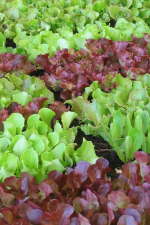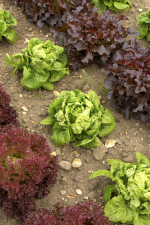Lettuce is so easy to grow that it should be in every vegetable garden and ‘cut and come again’ varieties are possibly the best of the bunch.
‘Cut and come again’ means that, instead of harvesting the whole lettuce in one go, only the leaves are picked leaving the smaller ones to keep growing. This way, one lettuce plant will keep producing lots of leaves over several weeks. These lettuces come in different colours and shapes and ‘salad mix’ is a combination of these.
PLANTING
In the summer months, lettuce seedlings grow best in part shade but during the other times of year they do well in full sun.
To plant lettuce seedlings into the ground, prepare the soil by removing any weeds and then dig lots of compost through the topsoil so that it holds plenty of water. Use a dibbler or a large stick to make small holes about 20cm apart and place one seedling in each one. Gently push the soil around the roots and water lightly.
Lettuce is the perfect plant to grow in pots as it can be mixed up with other herbs and vegetables and doesn’t take up much space. Simply fill a large container with premium potting mix, plant the seedlings and give them a water. Be sure not to let the soil dry out.
Plant another crop of lettuces in 4 to 6 weeks so that the family always has a good supply.
CARE AND MAINTENANCE
Although lettuce is easy to grow, its leaves are full of water and if they dry out they will wilt and become bitter. To stop this from happening, water lettuce every day and possibly even twice a day in summer. Feeding them with a liquid fertiliser every fortnight will help them to keep producing new leaves. Keep an eye out for aphids and snails as these pests like lettuce even more than you do!
Towards the end of their growth cycle, lettuce plants will ‘bolt to seed’ which is where they send up a flower stem from the centre. At this stage the leaves become bitter and its probably best to plant some new seedlings.
HARVESTING
Lettuce can be harvested as soon as the leaves are large enough. Harvest the outer leaves first by tearing them off; this will allow new leaves to grow from the centre of the plant. Harvest often as this will encourage new growth.
HOW TO EAT
Lettuce leaves only need to be washed and dried before they are used for salads or sandwiches. Don’t use a metal knife to cut lettuce though as this will cause the leaves to go brown, a bit like rust.
Take a look at our recipes in the Smarty Plants Kitchen.
HOW THEY GROW
Lettuce seedlings look just like a mature seedling except they are much smaller. After they are planted, they grow very quickly to form leafy heads of lettuce that can be different shades of green or red.
FAST FACTS
Botanical Name: Lactuca sativa
Life Cycle: Annual
When to Grow: All year round.
Height/Width: 30cm x 30cm.
Requirements: Water the plants every day and twice a day in summer. Apply liquid fertiliser every two weeks and keep a look out for those pesky snails.
Nutritional Benefits: Lettuce is about 95% water so is very cooling to eat in summer. It does contain some vitamin C and folate.



